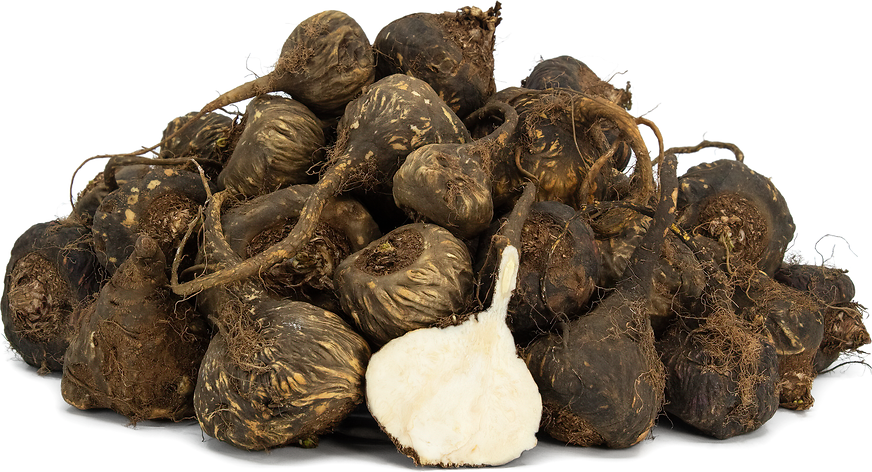


Black Maca
Estimated Inventory, lb : 0
Description/Taste
Black maca is small in size, averaging 3-5 centimeters in diameter and 10-14 centimeters in length, and can vary considerably in shape from globular, ovate, rectangular, to triangular. Above ground, many short, flattened green stalks grow up to twenty centimeters in length with lacy green leaves forming small rosettes laying on top of the soil. Below ground, the black to dark purple root is gnarled, lumpy, and covered in folds and fine, root hairs. Inside the root, the color ranges from a crisp white to a blend of purple and white hues, and the flesh is dense, firm, and crisp. When cooked or ground into a powder, Black maca has a nutty, sweet, and slightly bitter flavor.
Seasons/Availability
Black maca is available year-round.
Current Facts
Black maca, botanically classified as Lepidium meyenii, is an herbaceous plant grown for its nutritious root and is a member of the Brassicaceae family along with cabbage, kale, and broccoli. Also known as Peruvian ginseng, Black maca root is native to the Andes mountains in Peru and is one of the few crops that is grown in high elevations reaching over 4,300 meters above sea level. Black maca is considered the rarest of all the maca roots, only making up about fifteen percent of the total maca harvest, and is valued for its high amount of nutrients and phytochemicals. Considered to be an adaptogen or a plant that can help balance stress and improve the body’s resistance to disease, Black maca root is most commonly found outside of Peru in powder form.
Nutritional Value
Black maca root is an excellent source of phosphorus, calcium, magnesium, vitamin C, copper, potassium, and iron. It also contains zinc and vitamins A, B, and D.
Applications
When whole, Black maca root is typically harvested and dried in the sun. In Peru, some locals choose to eat the dried root raw, but the majority prefer to boil the root to soften its texture and eliminate any potential adverse effects. Outside of Peru, the root is sold in powder form and is used as a nutritional supplement in tea, smoothies, oatmeal, shakes, and juices. It can also be used as a flour in baked goods such as bread, cakes, muffins, and protein bites. In addition to food, Black maca is used in a liquor known as Zamaca, which pairs Black maca with elderflower, spice, and a secret ingredient. The roots will keep up to two years when stored whole and dried. In powder form, it will keep up to one year at room temperature and up to two years when stored in the freezer.
Ethnic/Cultural Info
In Peru, Black maca was highly prized in the Inca Empire, used as a nutritional supplement and item for trade. The Incans believed that Black maca provided increased fertility, energy, and stamina, and the warriors of the empire often consumed the root before battle as a way to increase their performance and recovery time. Black maca was also used in trade, and highland merchants would exchange the root with lowland merchants for valuable crops such as quinoa and corn. Today Black maca is still frequently used in Peru as a dietary supplement, and instead of local trade, the maca industry has expanded, globally exporting the root to other countries in powder form as a nutritional aid.
Geography/History
Black maca is native to the high altitudes of the central Andes in Peru, specifically the Junin Plateau, and has been cultivated since ancient times. Growing at four thousand meters and above in harsh winds and weather, Black maca was first described in 1553 by a Spanish chronicler and remained primarily localized to South America until recently, when it began to be exported to countries such as the United States and China due to increasing popularity. Today Black maca can be found whole and dried at local markets in Peru, and in powder form, it can be found online and at specialty grocers in North, Central, and South America, Asia, Europe, and Australia.
Recipe Ideas
Recipes that include Black Maca. One
| The Maca Team |
|
Maca Coconut Whip Strawberry Sundae |
| The Maca Team |
|
Maca Gingersnap No-Bake Treats |




